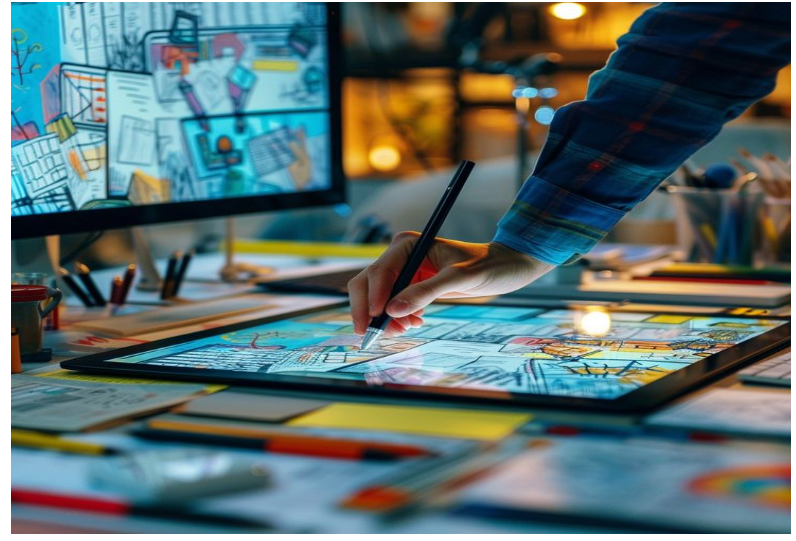Let’s be honest — graphic design can feel like a nightmare. You’re not a designer, but somehow, you’ve found yourself creating flyers, Instagram posts, or a pitch deck from scratch… with zero guidance.
You’re a business owner trying to make your brand look decent until you can hire a team. Or maybe you’re a digital marketer suddenly expected to “just whip up” creatives for the next campaign.Or you’re a creative who loves content, but can’t figure out why your designs aren’t giving what they’re supposed to give.
We get it. You’ve sat for hours on Canva, clicking Undo like your life depends on it. You’re frustrated. You’re not alone.
And the truth is — most times, it’s not about skill. It’s about clarity.
Graphic design is less about being a “creative genius” and more about understanding a simple pathway that can guide your thinking. Today, we’ll walk you through that pathway. Think of it as your no-fluff roadmap to making better graphics — without pulling your hair out.
Step 1: Start With the Message
Before you open Canva or scroll through Pinterest, pause and ask:
“What exactly am I trying to say?”
Because at the core, design is communication.
Your post, flyer, or ad is a message — and that message needs to be clear, succinct, and audience-friendly. You’re not trying to win an art contest. You’re trying to inform, attract, convert, or drive action.
When the message isn’t clear, the design can’t help. And when the design is overloaded (too much text, too many icons, a rainbow of colors), your audience scrolls right past.
✍🏽 Tip: For social media, outdoor billboards, and digital ads — less is always more.
Step 2: Find a Reference (Yes, Steal It)
There’s a reason Austin Kleon titled his book Steal Like An Artist.
He wrote:
“You don’t want to look like your heroes. You want to see like your heroes.”
What does that mean for you? It means you don’t have to start from scratch.
Start by curating references:
Pinterest, Instagram, Behance, even design templates you’ve seen online.
Look for layouts, color combinations, image styles, and font pairings that speak to you.
Great designers don’t create in isolation. They borrow, remix, and innovate on what they’ve seen. You’re allowed to do the same — especially if you’re still learning.
Step 3: Replicate the Reference
This is where learning begins.
Use the reference as a skeleton. Try to replicate the design exactly — even if it feels like “copying.” Because it’s not about showing off originality yet — it’s about training your eyes and hands to understand how good design works.
Fonts. Spacing. Color hierarchy. Alignment.
The best way to understand them isn’t from a textbook. It’s from doing.
Step 4: Adapt. Make It Yours.
Once you’ve replicated the reference, it’s time to tweak. Switch out the colors to fit your brand. Swap the imagery. Reposition the elements.
Maybe the original design had text aligned left — but your own version looks better centered. That’s the creative voice kicking in.This final stage is where you move from “copying” to creating.
🧭 Why This Model Works
This pathway isn’t just a hack. It’s a foundation.
- You learn the unspoken rules of design — like white space, balance, and contrast — by observing them in action.
- You grow by doing. The more you replicate, the more you recognize patterns. Eventually, you stop needing references to get started.
- You avoid burnout. Instead of starting with a blank page and endless anxiety, you work with structure — which saves time, reduces mistakes, and builds confidence.
So yes, start with Canva. It’s beginner-friendly and powerful enough to get things done.
Final Word
If you’re wearing multiple hats — business owner, marketer, content creator — this method will serve you well. It’s simple, practical, and good enough to carry your brand visuals while you focus on your real job: growing your business, building your platform, or managing your team.
But if you know deep down that you want to go further — that you want to compete with the best, become a top-tier designer, or run a world-class creative brand?
Then let this method be your training wheels — not your finish line.
Take courses. Study the greats. Learn from legends like Chris Do, Jessica Walsh, Mike Janda, and Sagi Haviv.
Design is a skill, and like all skills, it sharpens with intention and investment.
Until then — build, borrow, and become. You’ve got this.
